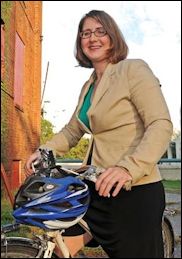by Amy George
Riding a bicycle can be transformative to physical and mental well being, to families, to neighborhoods, and beyond. As cycling becomes more popular, more women and girls are enjoying its effects. However, representation among cyclists still tips male — 76% as measured per-ride in the U.S. Yet recent surveys show women overwhelmingly have a positive view of cycling. What is keeping so many women from taking to the streets on two wheels? Furthermore, why should we care, and what can be done about it?
Since 2010, Richmond as a community has taken several big steps in bicycle advocacy. RideRichmond formed that year, as did Mayor Dwight Jones’ Bike, Trail, and Pedestrian Commission. We have seen the creation of the dedicated, professional action and advocacy groups such as Sportsbackers’ BikeWalkRVA and the VCU RamBikes program. In this landscape of growing bike-positivity, RideRichmond realized that women’s representation still is an underserved aspect of cycling advocacy. As believers in the bicycle, we could not stand by and watch the benefits of cycling distributed unequally to Richmonders. In order to begin this conversation, RideRichmond is hosting the first Richmond Women’s Cycling Summit on October 23 at the Virginia War memorial.
Fortunately, we’re riding a wave of good research and Women’s Cycling efforts across the nation. The long-held line on women’s resistance to cycling was one of “fear and fashion”. (“The cars! The helmet hair!”) It turns out, when you really ask women how they feel about cycling, the answers are much more practical.
The League of American Bicyclists’ excellent Women On A Roll report proposes five C’s that will get more women biking. These address the eight major issues that most surveys report as the barriers to women and cycling. Some highlights:
Convenience. It should be easy to park your bike wherever you go: work, shopping, entertainment destinations. Bike-friendly retail makes good business sense, and women statistically make more shopping trips and control more of their household’s disposable income. At work, access to lockers and showers alleviates concerns about storing clean clothes and grooming. Transit connections, especially express buses, can “multiply mobility” by traversing high-speed arterials and highways, with the bike as a means of transport for the first/last mile. (Biking to the current GRTC Park-and-Ride locations is a daunting prospect.) Plus, there are other, less tangible needs such as more flexible working hours for parents (both moms and dads), and more walkable neighborhoods that safely allow children to transport themselves to school and after-school activities.
Confidence. Aggressive and distracted drivers threaten everyone, but women are more likely to admit fear. Bike education can begin at school, first in Phys. Ed. and continuing through driver’s education. One day in a Traffic Skills 101 class can equip young cyclists and their parents with knowledge of skills like proper lane positioning (to prevent “dooring”) and simple, safe evasive maneuvers. Parents can teach basic maintenance techniques like changing a flat tire and secure locking in an afternoon. Even the students that don’t take to cycling will become drivers who know “Share the Road” as a practice, not just a pithy slogan.
Consumer Products. Sixty percent of bicycle owners 17 to 28 are women. Bicycle riding ranked 9th of 47 popular sports for total female participation in 2011, surpassing yoga, tennis, and softball. But many adult bike models don’t include a size small enough to fit a rider under 5’4”. A woman who can find a bike to fit her must then contend with frames and apparel mostly in pink, lavender, powder blue, and florals. These designs might stand on their own, but can you imagine tennis or softball gear selling in these “soft” presentations?
Community. The fun of riding a bicycle is amplified when you ride with others. Whether for enjoyment, fitness, or as transportation, it’s important to frame bicycling as an everyday activity. Invite a friend to go for a ride. Have a destination or reward. Lead no-drop rides. Help your daughters understand that bicycles are fun, but not merely toys. Incorporate cycling into family’s activities.
Consider for yourself whether it’s better to look fat on a bike, working toward your fitness, or in a car, making zero gains to your health. We are all busy, and making the time to dedicate to fitness is a challenge, but cycling is an easy way to workout while also being social, doing errands, or commuting.
On a larger scale, focus on local advocacy with an eye to equity and connecting lower income neighborhoods with access to jobs, food, and services. Vote for candidates that support high levels of funding for alternative transportation and infrastructure.
If the idea of encouraging a healthier, happier, region for all sounds appealing, it is our hope that you join us on the 23rd to become a part of this growing effort.
Amy George is the Women’s Cycling Summit Coordinator.



